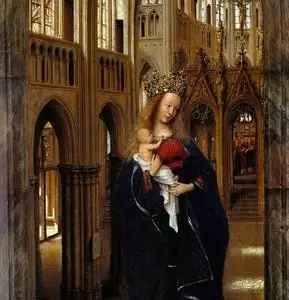Title of Artwork: “The Madonna in the Church”

Artwork by Jan van Eyck
Year Created 1437 – 1439
Summary of The Madonna in the Church
Jan van Eyck’s early oil painting, Madonna in the Church (or The Virgin in the Church), is a tiny panel depicting the Virgin Mary. In a Gothic cathedral, the Virgin Mary is depicted as she holds the Christ Child. This depiction of Mary is reminiscent of the Eleusa icon, a 13th-century Byzantine icon depicting Mary as the Queen of Heaven with a jewel-studded crown over her head, holding a lively child Christ (Virgin of Tenderness).
All About The Madonna in the Church
There are wooden carvings showing Mary’s life, as well as a faux bois sculpture depicting her carrying the infant in a similar stance, in the arch at back of the nave. It appears to Erwin Panofsky that the primary characters in the painting are intended to be sculptures that have come to life. Across the room, two angels are humming hymns from a hymn book.
As depicted in previous Byzantine Madonnas, van Eyck depicts a gigantic Mary that appears out of proportion to her surroundings. In this panel, the cathedral’s windows are depicted as rays of sunlight. In the end, two pools are formed on the floor as a result. Mary’s virginal purity and God’s ethereal presence are both evoked by the light, which has symbolic importance.
Almost all art historians believe the panel to be the left side of a broken diptych, with the right side being thought to be a votive portrait. One depicts a donor kneeling in an interior; the other shows the donor being presented by St. Anthony in an outdoor setting. Near contemporary copies by the Master of 1499 and Jan Gossaert couple it with two separate right-hand pictures.
It is possible that both artists made considerable adjustments to van Eyck’s composition to better reflect modern aesthetics, although the reproductions have been regarded as “spiritually devastating to the original design” because of these alterations.
History of the Church’s Madonna began in 1851. Since then, researchers have been debating the origins of the work and its date of origin. Once supposed to be the work of Jan’s brother Hubert van Eyck, it is now recognised as the work of Jan and considered to be a later work that displays methods common to works from the mid-1430s and later. In 1874, the Berlin Gemäldegalerie purchased the panel.
In 1877, it was stolen and returned quickly, but without its original inscribed frame, which was never found. Millard Meiss noted that the “splendour and intricacy” of its representation of light in Madonna in the Church is unrivalled in Western art, making it one of van Eyck’s best works.
Early Netherlandish art historians in the late 19th and early 20th centuries influenced the panel’s attribution. According to current estimates, it was completed around 1438–40 however there are still claims for a 1424–29 completion time.
It was claimed that this panel was painted by Jan’s brother Hubert van Eyck in the 1875 Gemäldegalerie catalogue and by art historian Georges Hulin de Loo in 1911 that the Turin-Milan Hours manuscript had pages assigned to Hand G. In the modern era, this is no longer considered believable, and Hubert is only acknowledged with a few works. According to the museum’s inventory, the picture was definitely painted by Jan by 1912.
Information Citations
En.wikipedia.org, https://en.wikipedia.org/.























